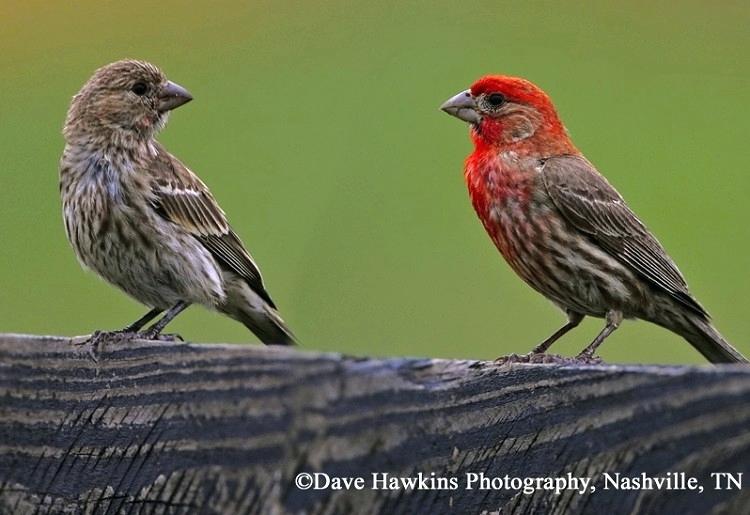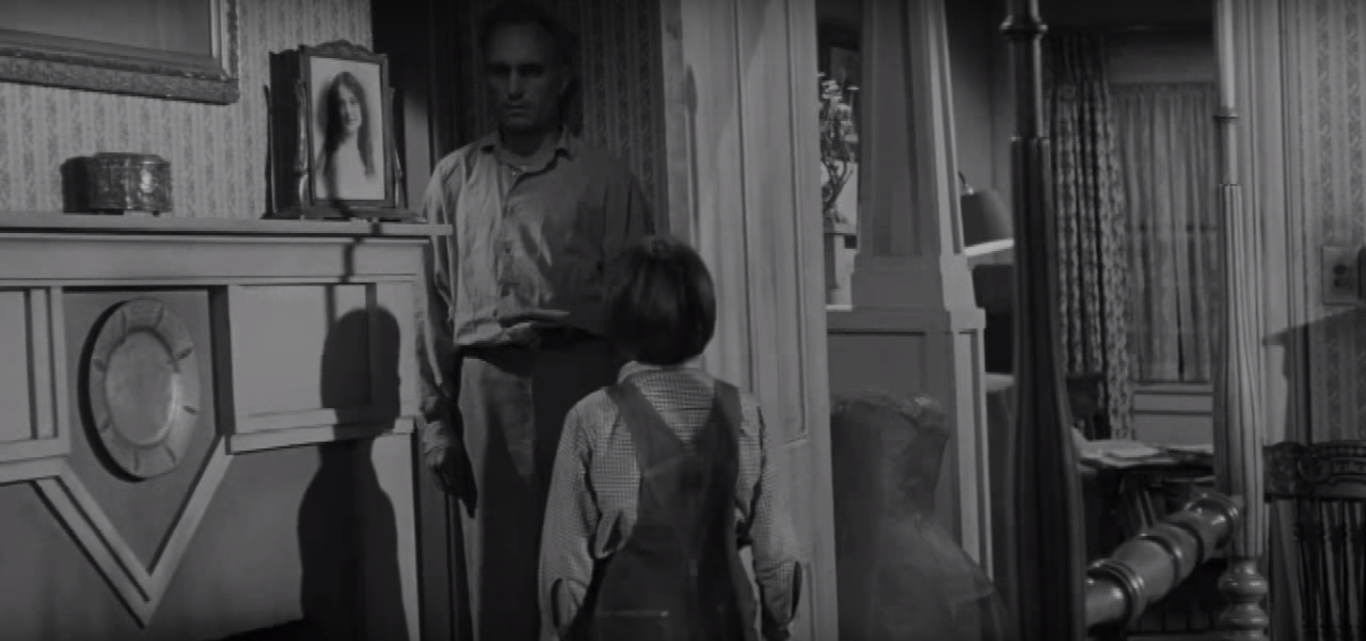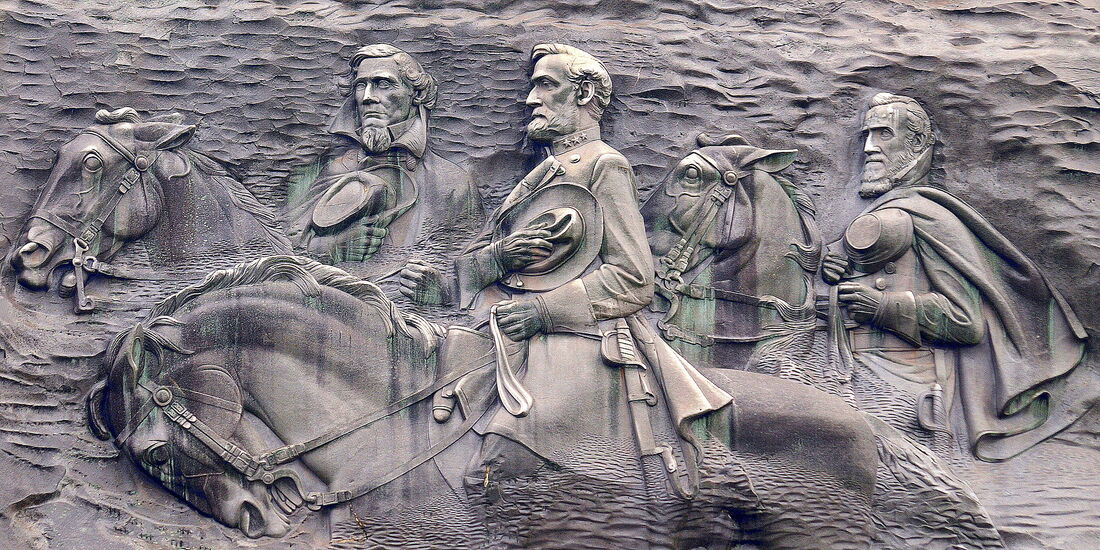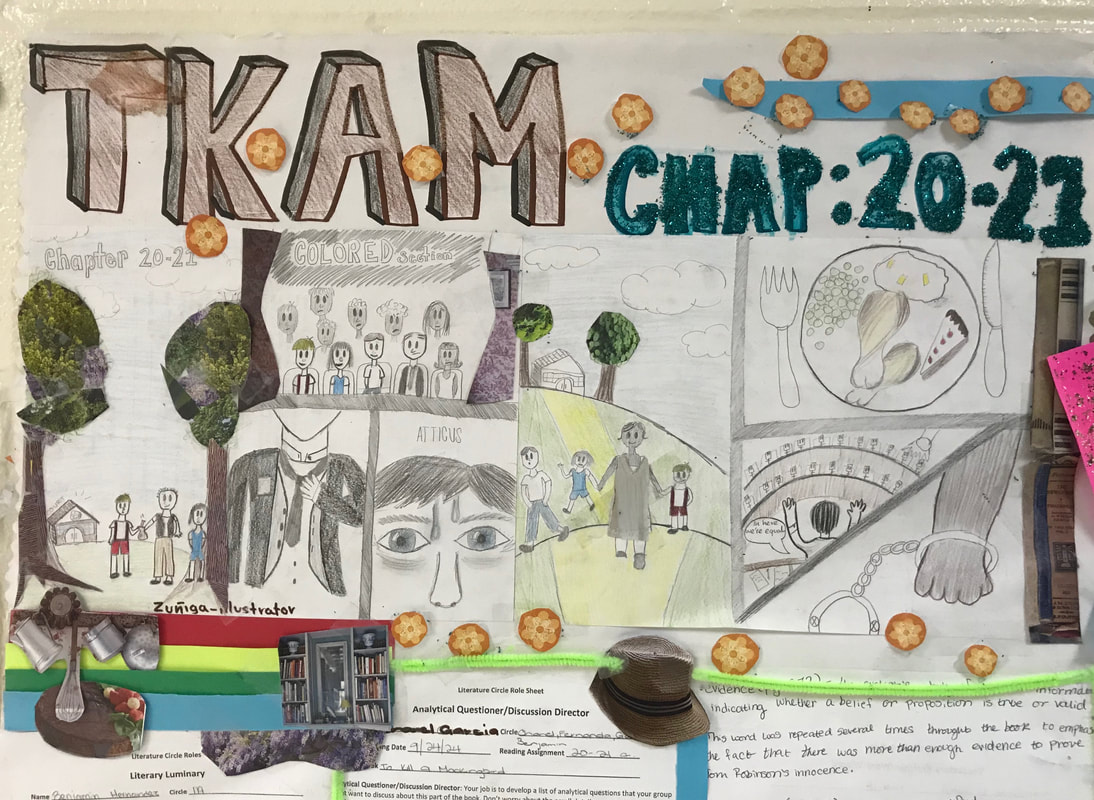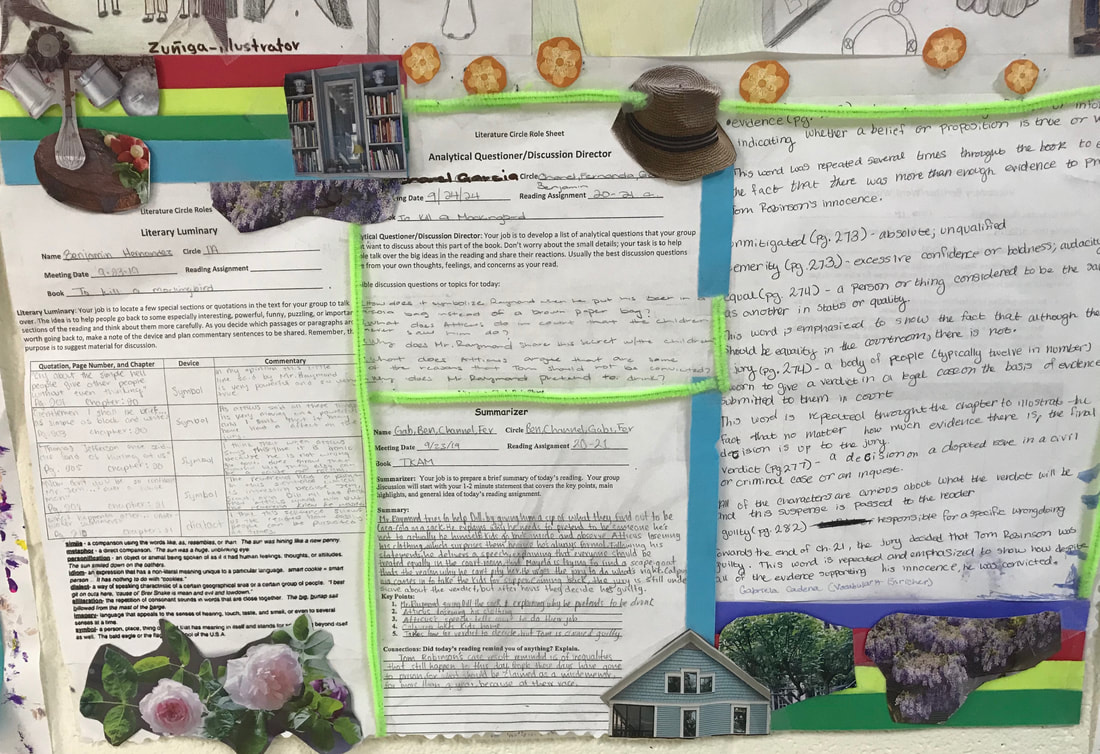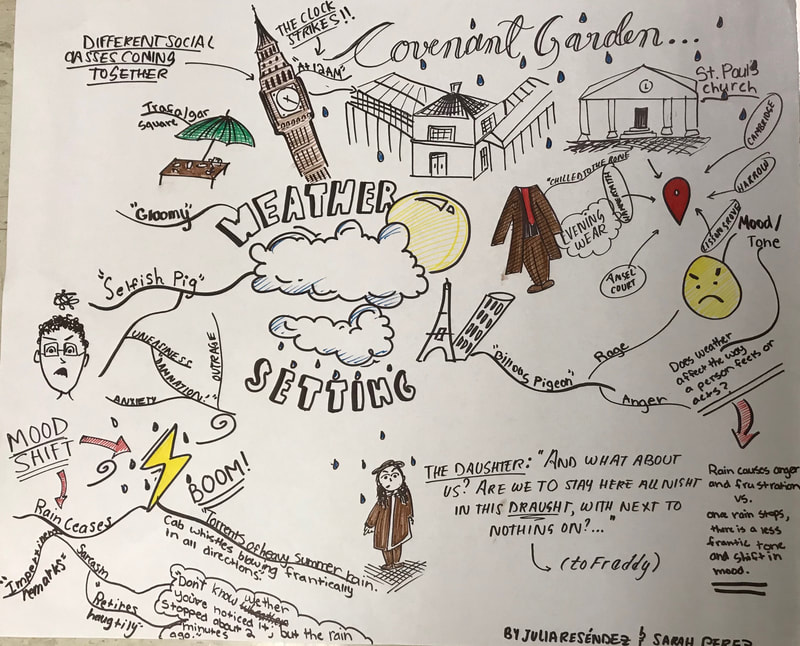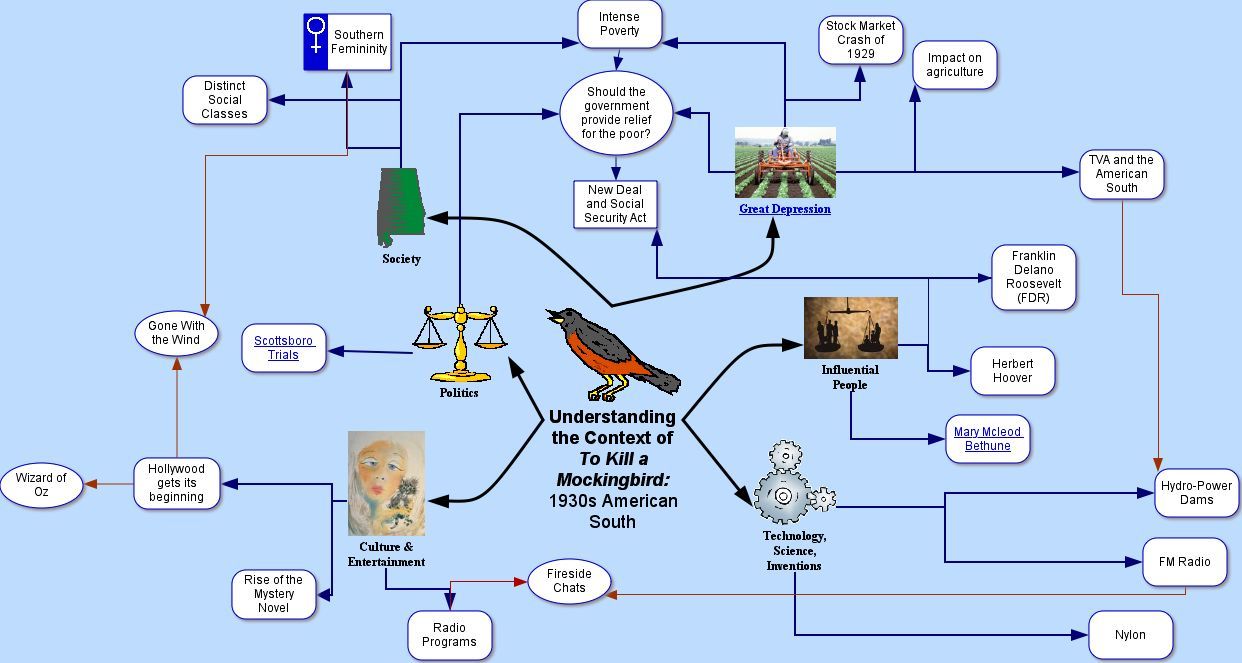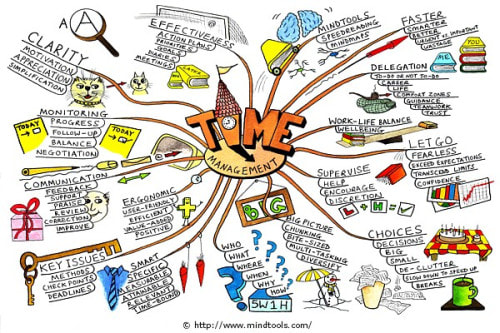To Kill a Mockingbird full text:
|
Last Week Tonight with John Oliver: Confederacy
|
|
Does TKAM Make You Feel Uncomfortable in Your Own Skin?
|
Set in the Deep South during the Great Depression, To Kill a Mockingbird begins on an idyllic note in which the older Jean Louise “Scout” Finch reminisces about her childhood in a small Alabaman town. However, it soon unfolds that the seed of hatred and violence buried deep in the south was now to grow into a behemoth and to shatter the calm façade of her sleepy town. Are you ready to find out what Scout has to say about growing up in a sexist and racist community? |
Read Along! |
Exposition: Chapters 1-10
Chapter 1
The older Scout reminisces about her childhood in Maycomb, Alabama--Arrival of Dill--Reclusive neighborhood spook, Boo Radley
1) What do you think happened to Jem when he was nearly 13-years-old?
2) In what ways could the Ewells have caused Jem’s injury?
3) Provide at least three details about the Finch ancestry in Maycomb County, Alabama.
4) List at least five details about the setting of Maycomb (5-6).
5) Why was Arthur grounded for life?
6) Why do you think Calpurnia called Mr. Radley “the meanest man ever God blew breath into” (13)?
7) What game does Dill devise? What tactics does he use to force Jem's hand? What ludicrous excuse does Jem have?
Vocabulary Might: to_kill_a_mockingbird_ch_1_vocab.docx
Grammar X-ray vision: grammar_x-ray_vision__chapter_1_.pdf
Chapter 2:
September, 1933--Scout's first day of school--Miss Caroline Fisher--The Cunningham family
1) Why was Scout punished by Miss Fisher?
2) Ms. Caroline Fisher failed in earning Scout’s respect. What skills or understanding did she lack in dealing with the Cunninghams as well as Scout?
Vocabulary Might: to_kill_a_mockingbird_chapter_2_vocab.docx
Chapter 3:
The afternoon and evening of Scout's first day of school; “Dinner” with Walter Cunningham and learning the hospitality code--Burris Ewell upsets Miss Caroline--The Ewells are “permitted to hunt and trap out of season”
1) In what ways do the Ewells differ from other impoverished white people such as the Cunninghams?
2) What have you learned about the Ewells? What does it foreshadow about Jem's injury?
Vocabulary Might: mockingbird_chapter_3_vocab.docx
Chapter 4:
Summer of 1934--Two pieces of chewing gum and two polished Indian heads in a knot hole--Dill comes back to Maycomb--Jem’s proposition to play “Boo Radley”--Overshooting the tire ride and “someone inside the house was laughing”
Vocabulary Might: mockingbird_chapter_4_vocab.docx
Chapter 5:
Scout under Miss Maudie’s auspices--Who are “foot-washing Baptists”?--How to coax Boo out of his house--A letter of invitation--“The oldest lawyer’s trick on record”
1) What do you think Miss Maudie implies by calling Mr. Radley a foot-washer--"You know old Mr. Radley was a foot-washing Baptist"?
Vocabulary Might: mockingbird_chapter_5_vocab.docx
Chapter 6:
The “shadow” on the Radleys’ porch--A midnight run in the collard patch and the “white nigger”--Jem’s foray to retrieve his trousers
Vocabulary Might: mockingbird_chapter_6_vocab.docx
Chapter 7:
Fall, 1934--two soap dolls, a pocket watch, and other miscellaneous token gifts--Mr. Nathan Radley fills the hole with cement--Jem weeps over the end of knot-hole communication
1) Why do you think Jem was crying at the end of Chapter 7? Please incorporate at least two quotations from the text within your response.
Vocabulary Might: mockingbird_chapter_7_vocabulary.docx
Chapter 8:
The coldest winter night--snow in Maycomb--a transformative snowman--childish revenge on Mr. Avery--Miss Maudie's house is burned to ashes--"Boo" and his blanket
Vocabulary Might: mockingbird_chapter_8_vocabulary.docx
Chapter 9:
Atticus agrees to defend Tom Robinson, a black man--Christmas dinner at Finch's Landing--Scout flaunts her curse words--Cousin Francis taunts Scout with racial baiting--Uncle Jack and Atticus discuss a looming trouble and ready Scout for it
1) Atticus agrees to defend Tom Robinson who is accused of attempting to rape a white woman (Mayella Ewell) fully well knowing that he is fighting a losing battle. What has made him accept such a difficult case? And what does this decision of his reveal about Atticus as a father and lawyer?
grammar_x-ray_vision.docx
Vocabulary Might: mockingbird_chapter_9_vocabulary.docx
Chapter 10:
Atticus is too old to be children's champion--why not to kill a mockingbird--Tim Johnson prowls down the road--Calpurnia alerts the community of the rabid dog--Atticus lives up to his old nickname, "Ol' One-Shot"--Atticus is not only a hero but also a gentleman.
Vocabulary Might: mockingbird_chapter_10_vocab.docx
Rising Action: Chapters 11-15
Chapter 11
Mrs. Dubose hurls racial slurs at the Finch children--Jem is now 12--Jem wields Scout's baton to behead Mrs. Dubose's prized camellia flowers--Jem does penance by reading Ivanhoe to Mrs. Dubose--Mrs. Dubose passes away after shaking off her morphine addiction--Atticus calls Mrs. Dubose a lady and extols her courage--Jem dwells on a Snow-on-the-Mountain, Mrs. Dubose's parting gift.
1) Part One ends with Mrs. Dubose’s death and Atticus eulogizes her life by saying “she died beholden to nothing and nobody. She was the bravest person I ever knew” (128). Even though Mrs. Dubose was a cantankerous racist while she lived, Atticus and Mrs. Dubose seem to share a certain character trait. What is this quality both of these characters exhibit?
2) Chapters Ten and Eleven are the last two chapters in the first part of the book. Explain why Harper Lee chooses to end the first part here.
3) There are many episodes in this novel in which the white color serves as one representative symbol of the community of Maycomb County: the Southern economy supported by cotton plantation; the snowman the Finch children create; and Mrs. Dubose's prized camellias (Snow-on-the-Mountain), In what ways do these references help create a specific symbolism that pertains to the south?
Vocabulary Might: mockingbird_chapter_11_vocab.docx
Chapter 12
Jem is growing up fast--Atticus serves in the state legislature--Calpurnia invites the Finch children to First Purchase African Church--Lula greets the party with hostility--a print reproduction of Hunt's The Light of the World on the wall--Reverend Sykes solicits collection for Tom Robinson's family--Zeebo "lines" hymnal lyrics for the congregation--How Calpurnia learned to read--Scout wants to visit Calpurnia's household.
1) What does Scout learn from her visit to First Purchase about the lives of the others--in particular, of the African-Americans of her community?
2) Explain why Calpurnia chooses to speak African-American Vernacular in First Purchase while she speaks standard English in the Finch household.
Vocabulary Might: mockingbird_chapter_12_vocab.docx
Chapters 13-15: events leading up to the trial
Chapter 13: Aunt Alexandra entertains Maycomb’s ladies
Agenda: Reproduce the social pyramid of the fictional Maycomb in the way Aunt Alexandra perceives her world.
How: Place the Finches, the Cunninghams, the Ewells, and blacks in the appropriate section as Aunt Alexandra assigns them in her mind.
Food for thought:
In such a society, do you think wrongs done to socially-disenfranchised people can be rectified? If you were born in such a culture, what line of action would you take to contend with the reality? Would you conform to or challenge the social norms?
Chapter 14: Dill runs away from home
Chapter 15: The Old Sarum mob tries to lynch Tom—Scout unwittingly intervenes
Read carefully the excerpt that describes the Maycomb jail and illustrate how the narrator conveys the sense of irony and ambivalence toward the judicial authority of Maycomb County. You may want to focus on her use of oxymoron, antithesis, and paradox.
The Maycomb jail was the most venerable and hideous of the county’s buildings. Atticus said it was like something Cousin Joshua
St. Clair might have designed. It was certainly someone’s dream. Starkly out of place in a town of square-faced stores and steep-
roofed houses, the Maycomb jail was a miniature Gothic joke one cell wide and two cells high, complete with tiny battlements and
flying buttresses. Its fantasy was heightened by its red brick facade and the thick steel bars at its ecclesiastical windows. It stood
on no lonely hill, but was wedged between Tyndal’s Hardware Store and The Maycomb Tribune office. The jail was Maycomb’s
only conversation piece: its detractors said it looked like a Victorian privy; its supporters said it gave the town a good solid
respectable look, and no stranger would ever suspect that it was full of ni****s.
To find more about irony, oxymoron, and antithesis, visit this page: www.drkaylee.us/figures-in-action/irony-oxymoron-and-antithesis
Chapters 16-21: the courtroom drama (climax)
the_courtroom_drama__chs._16-21.docx
16: Country folks come to see the trial in pomp and excitement
17: Sheriff Heck Tate is first interrogated--Robert E. Lee Ewell is then examined
18: Mayella Ewell is called to the witness stand--Mr. Gilmer questions her--Atticus cross-examines Mayella
19: Atticus calls Tom Robinson to the witness stand and questions him--Mr. Link Deas interrupts the court in Tom's defense--Mr. Gilmer cross-examines Tom--Dill is disturbed by Mr. Gilmer's treatment of Tom
20: Mr. Dophus Raymond lets Scout and Dill in on his "secret"--Atticus delivers his closing argument to the jury
21: Calpernia comes to fetch the children--a guilty verdict is delivered
1. How does Atticus employ logos, ethos, and pathos in his closing statement?
2. What does Jem expect the verdict to be? Does Atticus think the same?
3. What is unusual about how long it takes the jury to reach a verdict? Is the verdict predictable or not?
Watch the movie in its entirety:
|
|
Chapters 22-24: aftermath of the trial (falling action)
22: Miss Maudie validates and comforts Jem after a guilty verdict is delivered
23: The Finches discuss the jury system in Maycomb--Scout and Jem discuss the social caste of their town
24: The Maycomb ladies of the missionary circle have a social visit to the Finches--Tom is shot to death by the prison guards
Chapter 22:
1. Miss Maudie tells Jem that “things are never as bad as they seem.” What reasons does she give for this view?
2. Why does Bob Ewell feel so angry with Atticus? Do you think his threat is a real one, and how might he try to “get” Atticus?
Chapter 23 Analysis: tkam_chapter_23.docx
Chapter 24:
1. What does Mrs. Merriweather say about the Mrunas? How does her attitude change when she talks about Sophy, her domestic servant?
2. What lady-like virtue does Scout discover about Aunt Alexandra during the social hour with Maycomb's missionary society ladies?
3. In what ways, is Aunt Alexandra similar to Miss Maudie? In what ways, is Aunt Alexandra different from Calpurnia?
Mind Mapping: A Whole Brain Activity
Choose one main concept from the list below and develop a mind map exploring this concept as it is developed in the text, To Kill a Mockingbird. You are encouraged to use visual images, emblems, symbols, as well as selections of detail from the text. Your main concept SHOULD be related to two other concepts, but please do not lose your focus: your goal is to elucidate this concept to the equally-informed audience using one central concept to illustrate the complex aspects of this novel.
Themes: growing up; southern femininity; religion; legal injustice; racism; discrimination; parenting; education; friendship; art versus reality; class conflict; moral accountability
Setting: Maycomb; American South; 1930s; Court; the Finch household
Characters: Atticus; Scout; Jem; Boo; Calpurnia; Aunt Alexandra; Tom Robinson
Grading Rubric: tkam_mind_map.docx
Chapters 25-27: Falling Action
25: September 1935--Scout relays what Dill witnessed when Atticus and Calpurnia visited Helen with the unspeakable news--Mr. B. B. Underwood writes a haunting obituary of Tom Robinson
26: Things settle down--Miss Gates gives a current affairs project to Scout's class--Jem gets testy about Scout's report of what Miss Gates has said
27: Bob Ewell haunts Judge Taylor and Helen Robinson--a back story about last Halloween (a comic relief)--Jem and Scout prepare for the Halloween pageant--now it is October 31, 1936
1) Let's revisit Chapter 24, in which Mrs. Merriweather was vocal about her support for the Mrunas and the missionary Mr. Grimes. Yet, she was very hard and disparaging about Sophy, her domestic servant. Which character in Chapter 26 reveals her double standards about the persecuted? And why do you think Scout is disturbed about this character?
2) What superstition does Aunt Alexandra voice at the end of Chapter 27? What other superstitions do you recall that Scout, Jem, and Dill claim to believe in?
3) In Chapter 27, Scout relays three incidents in which Bob Ewell has been involved. What do you think these meddlesome behaviors Ewell exhibits portend? In what ways do you think Bob Ewell's lingering presence is related to "the longest journey" Scout talks about?
Resolution (denouement): Chapters 28-31
Chapters 28-31: the longest night
28:
29:
30:
31:
|
|
|
|
